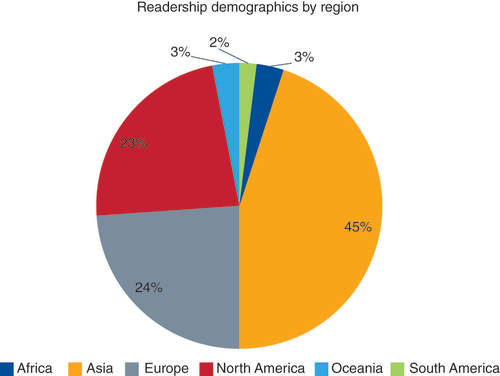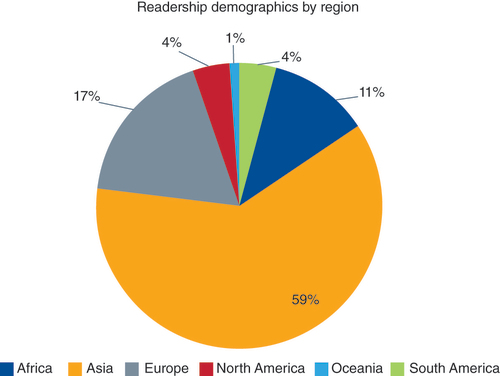Keywords::
Greetings, happy new year and welcome to the 16th volume of Future Medicinal Chemistry. Let us look back at the year that preceded and forward to the year ahead.
Key highlights
In volume 15 of Future Medicinal Chemistry, a total of 147 articles were published, spanning broad spectrum of contemporary issues in the field. We pride ourselves on the impactful original research that forms the backbone of our journal and work with authors from across the world in the pursuit of cutting-edge research. Our best received article this year was Šimková et al.‘s “Improving the antimicrobial activity of old antibacterial drug mafenide: Schiff baes and their bioactivity targeting resistant pathogens”, in which the authors reported promising results from structural modifications to the sulfonamide drug mafenide, incorporating imine moieties to create promising candidates boasting good resistance against antibiotic-resistant microbial strains, including methicillin-resistant Staphylococcus aureus (MRSA) and vancomycin-resistant S. aureus (VRSA) [Citation1].
In volume 15, 28 reviews were published, each offering a unique perspective and critical analysis of the existing literature in their respective fields. Although each review is in its own right noteworthy, our most well received review form the year so far was Weng et al.’s “An update on the recent advances and discovery of novel tubulin colchicine binding inhibitors” in which the authors explored novel small-molecule inhibitors of the key colchicine binding site [Citation2].
As a supplement to our research and review output, we published 29 added value content articles in the form of editorial opinion articles and longer form commentaries. Over these shorter articles we gave experts the opportunity to provide a snapshot of cutting-edge work or lend their opinion to hot topic issues. One favourite from the editorial department was Xue et al.’s “Advances in inhibitors of potential tumor target FOXM1”, in which the authors discussed the latest advances in small-molecule inhibitors for proliferation-associated oncogenic transcription factors, previously considered to be undruggable [Citation3].
Special focus issues
We are hoping to follow on from the success of previous special issues to publish more impactful special issues on the bleeding edge of medicinal chemical research. If you have a topic that you believe is deserving of particular attention, or that you would like to see an issue dedicated to, you can submit your proposals online [Citation4].
Insights into readership & authorship
Over the course of 2023, Future Medicinal Chemistry articles were read in 192 countries, crown dependencies and overseas territories, amassing over 200,000 unique readers. Looking regionally, Asia encompasses our largest readership demographic, encompassing almost half of our total readers. Nationally, China (including the territories of Hong Kong and Macau) tops our readership, with a significant proportion of our 97,000 Asian readers coming from China ().
Europe was our second largest demographic with an audience of 51,000 unique visitors, followed closely by North America, with 49,000. The USA was overwhelmingly the largest contributor to our North American statistics, with visitors from the USA and its dependencies. In Europe, the country with the largest share of readership was found to be the UK (including crown dependencies), with over 14,000 unique visitors.
Volume 15 saw contributors from nearly 30 countries and authors from all six continents bring their research, review and editorial pieces to the journal. Similar to last year, our two largest contributing countries were India and China, with 57 articles coming from those two countries alone. It therefore comes as no surprise that Asia comprised our largest authorship demographic when comparing regionally (). Europe comprises our second largest regional demographic, with 17% of all accepted papers coming from researchers based in Europe. On an upward trend from last year, the contribution from African authors has increased from last year, up to 11% from 2022’s 4%. We hope that this is a trend that continues and we hope to welcome research from all over the world in the coming year.
Article outreach & online presence
Future Medicinal Chemistry can be found across social media, and we are always excited to see our readers engage with us online. You can follow us on Twitter @fsgfmc and join our LinkedIn Group, Future Medicinal Chemistry, for highlights of the journal as well as all things medicinal chemistry [Citation5,Citation6].
Conclusion
I would like to thank our authors again for their hard work and support throughout the year. We are hoping that 2024 will be an even more exciting year for Future Medicinal Chemistry and we greatly look forward to working with you all. If you would like to submit a manuscript for us to consider, you can find details on our submissions process online [Citation7]. Lastly, do not hesitate to contact us for any other feedback.
Disclaimer
The opinions expressed in this Foreword are those of the author and do not necessarily reflect the views of Newlands Press Ltd.
Writing disclosure
No writing assistance was utilized in the production of this manuscript.
Financial disclosure
M Bell is an employee of Newlands Press The author has no other relevant affiliations or financial involvement with any organization or entity with a financial interest in or financial conflict with the subject matter or materials discussed in the manuscript apart from those disclosed.
Competing interests disclosure
The author has no competing interests or relevant affiliations with any organization or entity with the subject matter or materials discussed in the manuscript. This includes employment, consultancies, honoraria, stock ownership or options, expert testimony, grants or patents received or pending, or royalties.
References
- Krátký M , Konečná K , Šimková A et al. Improving the antimicrobial activity of old antibactreial drug mafenide: schiff bases and their bioactivity targeting resistant pathogens. Future Med. Chem. 15(3), 255–274 (2023).
- Weng H , Li J , Zhu H , Wong KFC , Zhu Z , Xu J . An update on the recent advances and discovery of novel tubulin colchine inhibitors. Sirtuin modulators: past, present, and future perspectives. Future Med. Chem. 15(1), 73–95 (2023).
- han XY, Zhou ZY, Li SY & Xue ST . Advances in inhibitors of potential tumor target FOXM1. Future Med. Chem. 15(10), 809–812 (2023).
- Future Medicine . Future Science Special Issue Proposal Form. www.futuremedicine.com/special-issues
- X.com (formerly Twitter) Twitter . Future Medicinal Chemistry Twitter Page. https://twitter.com/fsgfmc
- LinkedIn . Future Medicinal Chemistry LinkedIn Group. www.linkedin.com/groups/2822505/
- Future Science . Future Medicinal Chemistry. www.future-science.com/journal/fmc


